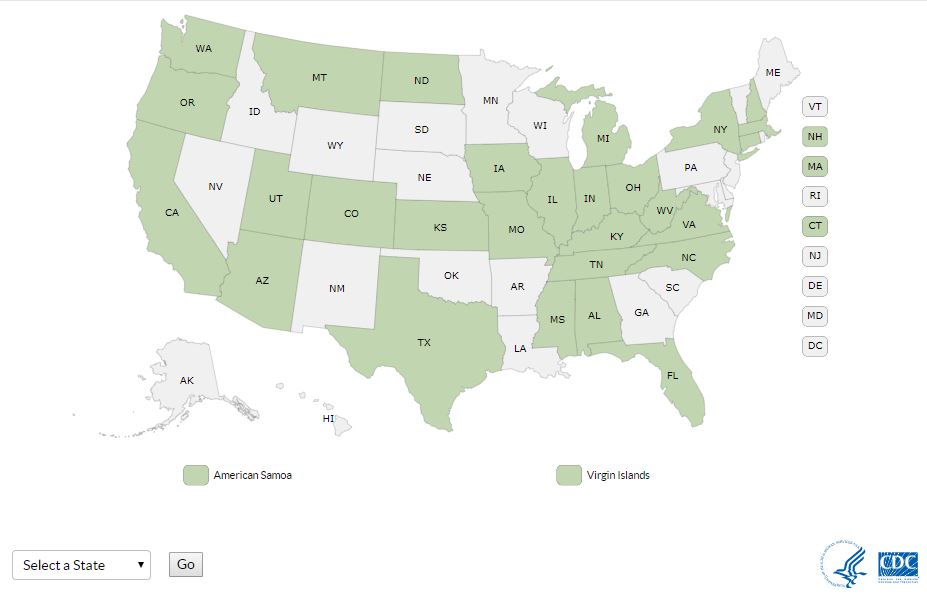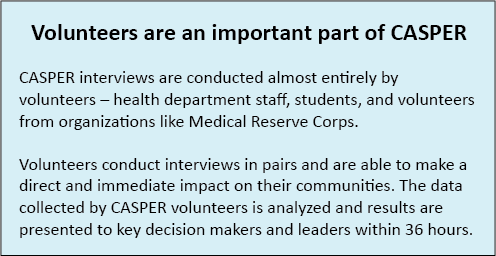Assessing Community Needs in Real-time
Posted on by
What if there was a way to evaluate the needs of a community after a natural disaster? Or understand a community’s attitudes and beliefs about a specific public health behavior? Enter CASPER: Community Assessment for Public Health Emergency Response, a tool for health departments and public health professionals to assess community needs in real-time.
What is CASPER?
CASPER is a type of rapid needs assessment that allows you to gather information about households in a community. It can be used to gather information during all phases of a disaster or to learn about household health status in a community. It is a quick, inexpensive, and flexible method of data collection that helps to guide response and recovery efforts after a disaster when needs may be changing and there are a lot of unknowns.
CASPER uses two-stage cluster sampling, which is a valid and reliable survey methodology. The first stage of sampling identifies 30 U.S. Census blocks. The second stage selects seven households from each block. Volunteers conduct face-to-face interviews with the household. The survey asks questions about household demographics, status (e.g. utilities, damage, etc.), communications, knowledge and beliefs, and physical and behavioral health. The interview concludes with an open-ended item asking about the household’s greatest need at the time of the interview.
CASPER data is typically collected over the course of two weekday afternoons. Information from a CASPER can be used to allocate resources, target programs, and meet the needs of community. Results have also been used to target communication messages and community education programs. The methodology also allows health and safety information to be disseminated during the interview process, so you can gather information about a community while also providing them with information.
How has CASPER been used?

CASPER has been used over 150 times across the United States in the past 10 years. Every CASPER is unique and questions are written based on a community and their specific needs. However, there is a question bank, so you can use questions that have already been tested in the field. Examples include the following:
- 2017 Hurricane Response and Recovery: U.S. Virgin Islands conducted two CASPERs after Hurricanes Maria and Irma to help guide the response efforts. A follow up CASPER was conducted 4 months later to determine if the community’s needs were being met and help guide continued recovery efforts.
- Zika Virus Response: U.S. Virgin Islands also used CASPER to understand household knowledge, attitudes, and beliefs about Zika virus transmission and prevention. Results from the CASPER informed awareness campaigns, community workshops, and online materials about Zika prevention, particularly related to the sexual transmission of Zika and the use of mosquito repellent.
- Flint Michigan Water Crisis: Public health officials and community leaders used CASPER in Flint, Michigan to understand behavioral and physical health concerns for households and the impact of the water crisis on the community. Results from the CASPER were used to focus behavioral health interventions and communication messages, as well as continued support for mental health services in the Flint community.
You can find where CASPER has been used across the U.S. using this interactive map. If you have conducted a CASPER be sure to use the CASPER Map Request Form to have it added to the map.
How can I do a CASPER?
You can conduct a CASPER any time you need to collect population-representative data, as long as the sampling frame has at least 800 households. A response CASPER may be initiated when at least one of the following conditions occurs:
- the effect of the disaster on the population is unknown,
- the health status and basics needs of the affected population are unknown, or
- when response and recovery efforts need to be evaluated.
If you work in a state or local health department and are interested in conducting a CASPER you can download the CASPER toolkit or email ghu5@cdc.gov to discuss if it is the appropriate tool for your needs. The Disaster Epidemiology and Response Team will provide technical assistance and training to help you identify objectives, provide expertise about sampling and mapping, and review questionnaires.
Amy Helene Schnall is an Epidemiologist on the Disaster Epidemiology and Response Team in the National Center for Environmental Health. She started her career at CDC in adolescent and school health, and took over the CASPER training program in 2010. Amy’s background in behavioral science and health education makes her a natural fit to lead disaster epidemiology trainings and work with state and local partners. Her work with the CASPER program has given the opportunity to travel around the country to conduct trainings and participate in response and recovery efforts.
The Communication Research and Evaluation blog series highlights innovative research and evaluation methods used at CDC to improve behavior change campaigns.
3 comments on “Assessing Community Needs in Real-time”
Comments listed below are posted by individuals not associated with CDC, unless otherwise stated. These comments do not represent the official views of CDC, and CDC does not guarantee that any information posted by individuals on this site is correct, and disclaims any liability for any loss or damage resulting from reliance on any such information. Read more about our comment policy ».
Kudos to all involved in the conception, development, and implementation of this tool. It seems to be very useful, especially seeing the number of times and variety of emergency situations in which it’s been successfully utilised.
It got me thinking. How was the very first CASPER developed? Who developed it and what was the initial emergency that brought about its development? I suppose it’s a validated tool. So, what method was used used to validate it and what theoretical framework(s), if any, were utilised in both its development and validation?
Finally, how can CASPER be tailored to non-US locations with very different sociocultural landscapes and norms while maintaining its effectiveness? Thanks for your kind response.
As an RN, it is very important to gather as much information as you can about patients and their surroundings. I think this is a good and effective system to use. When there is a disaster there are so many unknowns. This assessment will help eliminate some of those variables that may come in to play. I feel that this would be helpful to the local authorities as well, this assessment should be conducted in each affected household immediately following a disaster. Meeting the needs of a community is always a chore and to have one more tool to simplify the process would help tremendously. Even after a disaster the information gathered could be used for future references. I really appreciate the availability of being able to download the form.
Thank you for your interest in CASPER. CASPER is modeled after a World Health Organization (WHO) program to estimate vaccine coverage through use of a rapid needs assessment. In the 1980s, WHO researchers reviewed and validated the survey methodology; and the National Academy of Sciences identified the two-stage cluster sampling method as ideal to provide reliable health information quickly and at low cost. In 1992, CDC adopted the method for disaster response following Hurricane Andrew in Florida. CDC’s National Center for Environmental health coined the term “CASPER” with the publication of the first CASPER toolkit in 2009 to distinguish the two-stage cluster sampling method for public heatlh household-based information from other types of rapid needs assessments. As the technique was originally designed for developing countries, it can be, and is often, used in non-US locations. For more information or to request help with a CASPER, please contact the program at CASPER@cdc.gov. More information on the methodology can be found here: https://www.cdc.gov/nceh/hsb/disaster/casper/sampling.htm.